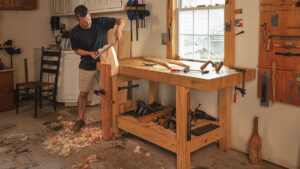Woodworking is more than just a hobby; it’s an art form that blends creativity, skill, and precision. Whether you are a novice eager to learn the basics or an experienced craftsman looking to refine your techniques, having a solid woodworking plan is essential. A well-thought-out plan serves as a blueprint that guides your project from conception to completion. Here’s a look at the key steps and considerations to help you craft your next woodworking masterpiece.
1. Define Your Project’s Purpose and Scope

The first step in any woodworking project is deciding what you want to create. Whether it’s a simple bookshelf, an intricate table, or a customized cabinet, clearly defining your project’s purpose will shape the entire woodworking plan. Ask yourself questions like:
- What function will the piece serve?
- Where will it be placed?
- Who will use it?
Answering these questions will help you determine the design style, size, and materials needed.
2. Choose Your Design
Once you have a clear idea of the purpose and scope of your project, it’s time to select or create a design. There are many woodworking design resources available online, in books, or from fellow woodworkers. Choose a design that matches your skill level and complements your style. Alternatively, if you are more experienced, consider designing your piece. This gives you creative control over every aspect, from the dimensions and materials to the intricate details that make your project unique.
3. Gather the Right Tools and Materials

A successful woodworking project relies heavily on having the right tools and materials. Depending on your design, you may need a variety of tools such as saws, chisels, clamps, sanders, drills, and measuring instruments. Likewise, choosing the appropriate type of wood is crucial. Consider factors such as:
- Hardwood vs. Softwood: Hardwoods like oak, maple, and cherry are durable and ideal for furniture, while softwoods like pine or cedar are easier to work with and suitable for decorative items.
- Grain and Color: The grain and color of the wood will affect the aesthetic appeal of your finished piece.
- Sustainability: If you’re environmentally conscious, look for certified sustainable wood options.
4. Develop a Detailed Plan
A detailed plan outlines every step of the woodworking process, from cutting and shaping to assembling and finishing. Break down the project into smaller tasks, each with specific instructions, dimensions, and materials. Sketch or create digital drawings of your design, noting all measurements and angles. This step is vital for minimizing mistakes and ensuring that all parts fit together perfectly.
5. Practice Safety First
Woodworking involves tools and machinery that can be dangerous if not handled properly. Make sure to wear protective gear such as safety goggles, gloves, and ear protection. Always follow safety guidelines for each tool, and keep your workspace clean and well-organized to prevent accidents. Remember, taking safety precautions is just as important as any other step in your woodworking plan.
6. Start with Precision Cutting
The foundation of any woodworking project is precision cutting. Accurate measurements are key, so double-check your dimensions and mark your wood carefully before cutting. Use sharp tools and take your time to make clean, straight cuts. For intricate cuts or joints, practice on scrap pieces first to avoid mistakes on the actual material.

7. Focus on Joinery Techniques
The strength and durability of your finished piece depend on the quality of your joinery. There are various types of wood joints, such as butt joints, dovetail joints, mortise and tenon joints, and lap joints, each with its own advantages. Choose the joinery method that best suits your design and skill level. Precision is crucial here; even small inaccuracies can weaken the joint or misalign the piece.
8. Assemble with Care
When it’s time to assemble the parts, dry-fit them first to ensure everything aligns perfectly. Use clamps to hold pieces in place while you check for gaps or unevenness. Once satisfied, apply glue sparingly to avoid excess squeeze-out, and clamp the pieces together until the glue sets. For added strength, consider using screws, dowels, or nails in conjunction with glue.
9. Sand and Finish
Sanding is the step that brings out the natural beauty of the wood. Begin with coarse-grit sandpaper to smooth rough surfaces and gradually move to finer grits for a polished finish. Pay extra attention to edges and corners. After sanding, clean the surface thoroughly to remove any dust. Choose a finish that enhances the wood’s natural grain and color, such as varnish, stain, oil, or paint. Apply it in thin, even coats, allowing each coat to dry completely before applying the next.

10. Evaluate and Enjoy Your Work
Once your woodworking project is complete, take the time to evaluate your work. Look for areas where you could improve next time, but also appreciate your craftsmanship and creativity. Woodworking is a journey, and each project offers new lessons and opportunities for growth.
For More Details:
Check out: 16,000 Woodworking Plans

